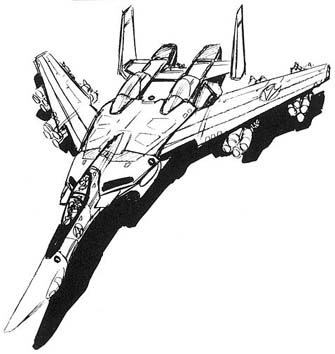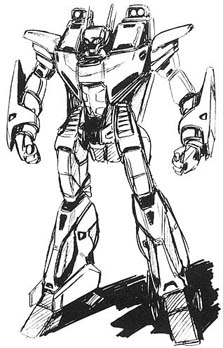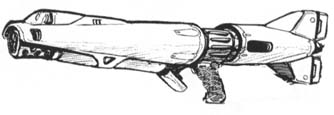VB-3000 "AARDVARK" VERITECH BOMBER
(Version 1.00 - Last updated:
12/10/01)
- Concept and Background by Kenneth
Olson
- Based on an original mecha design published in
Macross Design Works
- Background Information
derived from Robotech Technical
Files
BACKGROUND

At the conclusion of the First Robotech War, the United Earth
Government ordered a top down review of the Robotech Defense Forces. With
the launching of the Expeditionary Force and the continuing Zentraedi uprisings,
the need for a new generation of mecha units was apparent to the RDF high
command. Unfortunately, the next generation of veritech fighters,
primarily the VF-6 "alpha", would not be ready for almost a decade. An
interim solution was necessary and as a result several modified versions of the
venerable VF-1 was introduced between 2010 and 2020.
The RDF was in desperate need for a light bomber during the mid
2010's. The remaining conventional designs were at a minimum 30 years old
and proving to be extremely vulnerable to Zentraedi in South America. In
order to fill this role, the designers at Shinsei Industries modified their
newly created VF-3000 design. The bomber was designated the VB-3000
Aardvark, in honor of the F-111, and armed with the latest weaponry and armored
with the more advanced first generation Chobam plate. Unlike previous
veritech designs, the VB-3000 would required both a pilot and a weapon's officer
to operate.
The basic airframe of the VF-3000 was retained, however two more powerful
Nakajima FX-2006 fusion turbines were added to provide the additional thrust
necessary for the increased weapons load out. The structural support was
increased to allow for the increased mass placed under the wings. The
inner pylons are capable of holding up to 3000 kg of weapons and the outer
pylons can hold up to 2500 kg. This allows the VB-3000 to be loaded with
up to 16 long range missiles or up to 11,000 kg of more conventional bombs.
The VB-3000 possesses considerable laser and projectile weaponry. Two
LA-5 lasers are mounted in two nose blisters on either side of the pilot's
compartment, in a similar position to the VF-1. Each LA-5 is capable of
firing 4 MJ bursts up to 30 times per minute. Like the VF-3000, the
VB-3000 only has two head lasers. Each Mauser ROV-30 fires 5 MJ bursts and
is powered directly by the main protoculture generators. A single GU-20
120 mm smoothbore cannon is mounted underneath the bomber. Although the
damage potential of the GU-20 is greater than the standard GU-11 55 mm
tri-barrel cannon, the GU-20 only holds 60 rounds.
The most advanced sensor package available at the time was included in the
VB-3000. A pulse-Doppler AWG-30 radar was mounted in the nose of the unit
providing detection of a 0 dBsm target at ranges up to 120 km. In
addition, two of the head lasers on the right were replaced with a Marconi
Spyeye broad-spectrum radiation sensor and a TI-10000 onboard data
interpretation system.
The first operational squadron was introduced in August 2016 and immediately
placed into combat in South America. Previous to the the VB-3000, modified
versions of the VF-1 were used in the light bombing role. Pilots of the
new VB-3000 greeted the new plane with great enthusiasm as the newer design
offered more maneuverability, greater payload, and increased armor protection
over the VF-1. In all areas the VB-3000 was superior to the VF-1, the only
major difficulty with the VB-3000 was with the newly introduced FX-2006 turbines
which required more maintenance than the older designs.
The initial combat experience was so successful that 100 additional units
were added to supplement the original 36 and as a result the total number of
combat squadrons was increased to 13. Additional units were requested,
however the no bombers were approved by the RDF high command. Procurement
officers with the RDF had decided that all available funding for a light bomber
should be diverted to the VF-X-7 "Beta" fighter and not on what was essentially
a fighter design throwback from the previous war. The final VB-3000 was rolled
off the production line in 2018.
Unfortunately for the REF, the VF-X-7 was not ultimately successful. As
a result, the remaining VB-3000 bombers were brought with the REF. Once
again, the VB-3000 proved to be a successful design this time as a long range
missile platform. During the Sentinel campaigns VB-3000 were typically
outfitted with long range cluster missiles capable of breaking up incoming Invid
suicide squadrons. The VB-3000 continued to soldier on until the
introduction of the VF-12 in 2039 at which point the remaining 53 units were
quickly placed into reserve roles.
 RPG STATS
RPG STATS
- Vehicle Type: VB-3000 Valkyrie Bomber
- Class: Variable Bomber
Manufacturer: Robotech Defense Forces
Crew: Two, pilot and weapons officer wearing Tactical Life Support
System
- Service History:
- VB-3000A: RDF from 2016-2025
- VB-3000B: REF from 2025-2039
MDC BY LOCATION:
| Location |
Aardvark |
| Small Head Lasers (2) |
25 each |
| Head Sensor Probe |
35 |
| * Head |
75 |
| Hands (2) |
30 each |
| Arms (2) |
125 each |
| Legs/Engine Thrusters (2) |
225 each |
| ** Main Body |
300 |
| Reinforced Pilots Compartment |
250 |
| Retractable Utility Arms |
3 |
| Wings (2) |
150 each |
| Tails (2) |
50 each |
| GU-20 |
100 |
NOTES:
- * Destroying the head of the Aardvark will knock out the mecha's major sensor
systems, including all of the optics systems (infrared, nightvision, thermal). Radar and
communications will be unaffected.
- ** Depleting the MDC of the main body will destroy the mecha.
SPEEDS:
- RUNNING, SOLDIER CONFIGURATION:
- 120 kph
- LEAPING, SOLDIER CONFIGURATION:
- 50 ft (15 m) high or 70 ft (21 m) long without thrusters.
- FLYING, SOLDIER CONFIGURATION:
- 250 kph
- FLYING, GERWALK/SOLDIER CONFIGURATION:
- Mach One (670 mph/1072 kmph) maximum speed limit in an Earth-like atmosphere. Can also
hover in place indefinitely.
- FLYING, FIGHTER CONFIGURATION:
- Max level speed at sea level : Mach 1.1
Max level speed at 10km: Mach 3.5
Max level speed at 30+ km: Mach 4.5
- Stall speed : 150 kph (VTOL rectification possible)
Initial climb rate : over 25000m per minute
Service ceiling : 30 km (unboosted).
MAX ENGINE THRUST:
- 2 x NAKAJIMA/P&W/ROLLS-ROYCE FX-2006 FUSION TURBINES:
Total engine output 350 kN at max. power; 620 kN are available with overboost. Exhaust nozzles
allow for vector thrust, serving in place of conventional elevators. System includes two
reverse-vernier thrusters, on blisters outboard of each intake; exhaust comes directly
from main turbine at a maximum of 20% thrust.
- 4 x NAKAJIMA NBS-1 HIGH-THRUST VERNIER THRUSTERS: Four
thrusters are mounted in the 'backpack' of the mecha in Guardian and Battloid
mode and between the main engines in fighter. Each thruster has a total engine output of 50 kN.
STATISTICAL DATA:
- HEIGHT:
- 18.7 m in soldier configuration.
- 13.8 m in gerwalk configuration.
- 7.1 m in fighter configuration.
- WIDTH:
- 10.1 m at shoulders in soldier and gerwalk configuration.
- 14.8 m with wings at maximum extension.
- LENGTH:
- 14.1 m in gerwalk configuration.
- 16.1 m in fighter configuration.
- WEIGHT:
- 35,200 kg empty.
- PHYSICAL STRENGTH:
- Equal to a P.S. of 60
- CARGO:
- Small compartment behind pilot's and weapon officer's seat for personal
belongings
- POWER PLANT:
- Two RT-5E miniaturized protoculture-cell energizers providing a total of
800 MW total power
- DELTA V:
- 100 kps
- COMPATIBLE FAST PACKS
(Macross Mecha Designs):
- Dorsal: NP-BP-01, NP-BP-02, NR-BP-T1, NP-BP-10, NP-BP-11, NP-BP-12, NP-BP-19
Arm: NP-AR-01, NP-AU-T1
Leg: NP-FB-01, NP-FB-T1, NP-FB-10
WEAPON SYSTEMS:
-
 GU-20
120 MM SINGLE-BARRELED SMOOTHBORE: The GU-20 was designed to
replace the the GU-12 100mm designed for the VF-1. The GU-20 firings
120mm high explosive armor piercing rounds. The GU-20 is capable of
firing 100 rounds per minute from its internal ammunition supply of 60 rounds.
Like the earlier GU-11 and GU-12, the GU-20 does not have the capability of
being reloaded on the field.
GU-20
120 MM SINGLE-BARRELED SMOOTHBORE: The GU-20 was designed to
replace the the GU-12 100mm designed for the VF-1. The GU-20 firings
120mm high explosive armor piercing rounds. The GU-20 is capable of
firing 100 rounds per minute from its internal ammunition supply of 60 rounds.
Like the earlier GU-11 and GU-12, the GU-20 does not have the capability of
being reloaded on the field.
- PRIMARY PURPOSE: Assault
- SECONDARY PURPOSE: Anti-Mecha
- RANGE: 2000 m
- DAMAGE: 4D6 for each single shot, 1D6*10 for each short burst
(3 rounds), 2D6*10 for long bursts (10 rounds)
- RATE OF FIRE: Single shots or bursts equal to the combined
attacks of the pilot and/or weapon's officer.
- PAYLOAD: 60 rounds of internal ammunition sufficient for 20
short bursts or 6 long.
- 2 x LA-5 HEAD LASERS: Two LA-5 head lasers are mounted on the left
side of the head opposite to the sensor antenna. The lasers are capable
providing the mecha rear protection and can traverse 270 degrees in elevation.
Each LA-5 are capable of firing short bursts of 4 MJ up to 30 times per
minute.
- PRIMARY PURPOSE: Anti-missile
- SECONDARY PURPOSE: Assault
- RANGE: 600 m
- DAMAGE: 3D6 for each Head lasers or 6D6 if both are fired
- RATE OF FIRE: Single shots equal to the combined attacks of the pilot
and weapon's officer up to eight
times per melee.
- PAYLOAD: Conditionally unlimited.
- 2 x MAUSER ROV-30 LASER CANNONS: Two Mauser ROV-30 lasers are
mounted in the nose blisters on either side of the fuselage. The cannons
are powered directly from the main protoculture energizer and are capable of
firing 5 MJ bursts up to 40 times per minute.
- PRIMARY PURPOSE: Assault
- SECONDARY PURPOSE: Anti-mecha
- RANGE: 2000 m
- DAMAGE: 4D6 for each single burst or 1D4*10 for both
- RATE OF FIRE: Short bursts equal to the combined attacks of the
pilot and weapon's officer
- PAYLOAD: Conditionally unlimited up to 10 times per melee.
- 4 x BODY/WING HARD POINTS: Although the VB-3000 only has four
hardpoints, the same as the VF-1, the wings have been structurally
strengthened to allow the heavier payloads on all the hardpoints. The
inner two hardpoints are capable of mounting up to 3000 kg of payload whereas
the outer two hardpoints can mount up to 2500 kg.
- PAYLOAD INNER HARDPOINTS: Up to 3000 kg of weapons
(15 short range, 5 medium, or 4 long)
- PAYLOAD OUTER HARDPOINTS: Up to 2500 kg of weapons (15
short range, 5 medium, or 4 long)
- HAND TO HAND COMBAT: If necessary, the Aardvark can engage in melee combat
rather than use a weapon. The VB-3000 is extremely agile and can execute most
typical hand to hand combat moves, such as punches, jump kicks, leap attacks, rolling with
impacts, etc.
DAMAGE:
- Punch in Battloid: 3D6*3
- Punch in Guardian: 3D4*3
- Kick: 3D6*3
- Leap Kick: 6D6*3
- Body Flip/Throw: 3D6*3
- Body Block/Tackle: 3D6*3
- Stomp: 6D6*3 . (only effective against small objects)
STANDARD EQUIPMENT FOR THE AARDVARK:
- AUTO-PILOT: The Aardvark is equipped with a computerized auto-pilot, allowing
the pilot to relax or even sleep during long voyages. The auto- pilot can be programmed
with a single destination or a complex flight plan involving multiple speeds, directions,
and destinations. The onboard computer will alert the pilot when the fighter is near its
destination, and can also be set to automatically signal when sensors detect objects near
the mecha. The auto-pilot was designed with long intra-system space journeys in mind.
- TI-1000 COMBAT COMPUTER: The combat computer tracks and identifies specific enemy
targets, and has a database of over 10,000 images stored in memory. The computer can
identify and track up to 250 targets simultaneously.
- WESTINGHOUSE ALQ-250(V) ACTIVE SENSOR JAMMER
- EXTERNAL AUDIO PICKUP: Range: 300 ft (91.5 m). A sound amplification system that
can pick up normal conversation up to 300 feet away.
- HEAT AND RADIATION SHIELDS: Special shielding prevents the penetration of life
threatening head and radiation. A radiation detection and alarm system are linked with the
shields and will sound an alarm if there is a rupture in the shields and what the levels
of radiation are.
- HOMING SIGNAL: The escape pod of the VF-3000 is equipped with a
homing device that enables rescue teams to locate a disabled craft or ejected life pod.
The range of the signal is 400 miles (640 km). Most REF ships and veritecs can locate and
track a homing signal, and the onboard computers will automatically notify their pilots if
such a signal is detected.
- LASER TARGETING SYSTEM: Range: 100 miles (160 km). Used for increased accuracy in
the striking of enemy targets and is partly responsible for the mecha's strike bonus.
- LOUDSPEAKER: A loudspeaker system is built into the craft, which can be used to
amplify the pilot's voice up to 90 decibels.
- OPTICS: INFRARED: Range: 2000 feet (610 m). This optical system projects a beam
of infrared light that is invisible to the normal eye, but detectable by the mecha's
sensors. The system allows the pilot to detect hidden/concealed objects by their IR
reflectiveness. The beam will be visible to anyone with IR sensitive optics, however.
- OLDELFT INFRA-RED WARNING RECEIVER (IRWR)
- OPTICS: NIGHTVISION: Range: 2000 feet (610 m). A passive light image intensifier
that emits no light of its own, but relies on ambient light which is electronically
amplified to produce a visible picture.
- OPTICS: THERMAL IMAGER: Range: 2000 feet (610 m). A passive optical heat sensor
that detects infrared radiation projected by warm objects and converts that data into a
false-color visible image. The system enables the pilot to see in the dark, in shadows,
and through smoke, and also adds a +10% bonus to pilots using a tracking skill.
- HUGHES AWG-30 RADAR: 200 mile range.
- ELETTRONICA RADAR WARNING RECEIVER (RWR)
- RADIO/VIDEO COMMUNICATION: Long range, directional communications system with
satellite relay capabilities. Range: 600 miles (960 km) or can be boosted indefinitely via
satellite relay.
- SELF-DESTRUCT: To prevent capture of an advance variable fighter by the enemy,
the pilot can activate the self-destruct system, which will cause the fighter
to explode after a delay of up to 60 minutes (time is set by the pilot). The explosive
damage is contained within a 20 foot (6 m) area and inflicts 1D6*10 M.D. to everything
within the radius of the explosion. All internal systems are obliterated. The escape pod
will be automatically ejected prior to the explosion unless the pilot overrides the
ejection sequence.
- STANDARD SURVIVAL KIT: All RDFs veritechs come equipped with a portable survival
kit. Inside the small reinforced box is a medium-sized flashlight, two hand flares, one
rocket flare, a compass, infrared distancing binoculars, a small mirror, a pocket knife,
dehydrated and concentrated food (can be stretched into a five day supply for one person)
and basic first aid items (aspirin, bandages, disinfectants, etc.)
- TACTICAL LIFE SUPPORT SYSTEM: The Aardvark cockpit is pressurized, and also
provides additional air feeds to the pilot's flight suit that provides him with
pressurized breathing. The REF flight suit also contains an upper and lower g-suit that
promotes blood circulation even during high-g turns, thus decreasing the possibility of
pilot's blacking out in combat.
- CHAFF AND FLARE DISPENSERS 40 chaff and 40 flares are stored in each
lower leg
COMBAT BONUSES FOR AARDVARK TRAINING:
- 2 attacks per melee (plus those of the pilot and weapons officer).
- Add one additional action/attack at levels six and eleven.
- +2 to strike
- +2 to parry
- +1 to dodge in solder, +3 in guardian, and +5 in jet mode.
- +2 to roll with a punch or fall with an impact, reducing damage by half.
- Critical strike same as pilot's or weapon officer's hand-to-hand.
REFERENCES USED IN THIS DESIGN
Back to Mecha Home


 RPG STATS
RPG STATS GU-20
120 MM SINGLE-BARRELED SMOOTHBORE: The GU-20 was designed to
replace the the GU-12 100mm designed for the VF-1. The GU-20 firings
120mm high explosive armor piercing rounds. The GU-20 is capable of
firing 100 rounds per minute from its internal ammunition supply of 60 rounds.
Like the earlier GU-11 and GU-12, the GU-20 does not have the capability of
being reloaded on the field.
GU-20
120 MM SINGLE-BARRELED SMOOTHBORE: The GU-20 was designed to
replace the the GU-12 100mm designed for the VF-1. The GU-20 firings
120mm high explosive armor piercing rounds. The GU-20 is capable of
firing 100 rounds per minute from its internal ammunition supply of 60 rounds.
Like the earlier GU-11 and GU-12, the GU-20 does not have the capability of
being reloaded on the field.